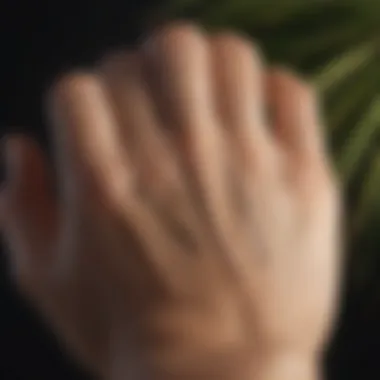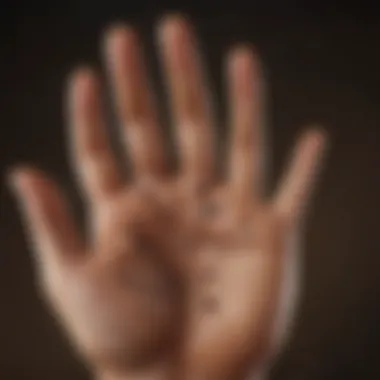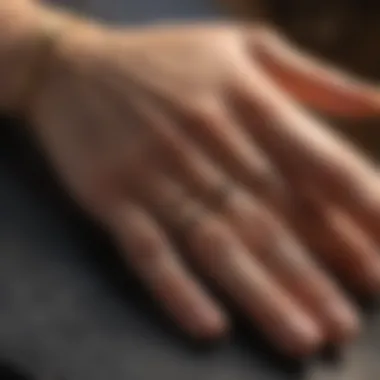The Life Line on the Hand: Discover Its True Meaning


Intro
The life line is often seen as the most significant feature on a person's hand in palmistry. Its presence and condition can suggest various aspects of an individual’s life journey. The life line is not merely a line. It stands as a reflection of vitality, health, and personal growth. However, interpretations can vary widely between different cultures and practitioners, lending a complex nature to this seemingly simple line. In this exploration, we will delve into the implications behind the life line, its interpretations, and the common misconceptions that surround it.
Understanding the Zodiac
In the realm of palmistry, some practitioners find value in intertwining the insights from zodiac signs with the interpretations of the life line. The zodiac can provide additional depth, offering perspectives on personality traits that may resonate with a person's life line.
Overview of Zodiac Signs
The zodiac consists of twelve signs, each possessing unique qualities. These signs are often associated with specific personality traits that can complement palmistry insights. Each sign corresponds to a sector of the celestial sphere known as the ecliptic. The signs in the zodiac include Aries, Taurus, Gemini, and others.
Sign Traits and Characteristics
Understanding the traits of each zodiac sign can aid in interpreting the life line. For example, someone born under Leo may exhibit confidence and assertiveness. In contrast, a Pisces individual may display sensitivity and emotional depth. Such traits can illuminate aspects of a person's life as reflected by the life line.
Elemental Qualities
The zodiac signs are divided into four elemental categories: fire, earth, air, and water. These elements influence how a person interacts with their environment and experiences life. Fire signs, for instance, tend to be more passionate, while earth signs are grounded and practical. Recognizing these elemental qualities can enhance the interpretation of how the life line manifests in an individual.
The Life Line in Palmistry
Geting deeper into the life line itself, several factors come into play. The length, depth, and curvature can reveal different narratives. A long and deep life line may signify a strong vitality, whereas a faint line could indicate a more cautious or tentative approach to life.
Common Misconceptions
It is crucial to address misconceptions about the life line. For instance, many associate a short life line with a short life expectancy. This belief lacks scientific grounding, as the life line primarily signifies life energy and experiences rather than longevity. Such misunderstandings can diminish the rich meanings ascribed to the line.
Interplay with Other Lines
The life line does not exist in isolation. It interacts with other lines present on the palm, such as the heart line and head line. Together, these lines can create a multifaceted view of an individual's potential and experiences. Understanding how these lines complement or contrast each other is critical for accurate palmistry readings.
Cultural Significance
Cultural differences play a significant role in how the life line is interpreted. In some cultures, palmistry has ancient roots, linking it to deep spiritual practices. In contrast, in others, it may be viewed more skeptically. Acknowledging these cultural contexts can enrich the practice of palm reading.
The life line is not a measure of duration but rather a depiction of one's journey and vitality.
Preamble to Palmistry
Palmistry, often referred to as chiromancy, is the practice of interpreting the lines and shapes of the hands to gain insights into a person’s character and future. This ancient art, prevalent in many cultures, emphasizes the belief that a hand reveals personal and spiritual information. The depth and complexity of palmistry make it a subject worth exploring, especially concerning the life line.
The life line particularly stands out as it reflects the essence of vitality and life experiences. Understanding this line can inform not only about health but also about the emotional and psychological journey a person may encounter. As palmistry gains renewed interest in modern society, it is essential to grasp its fundamentals.
Defining Palmistry
Palmistry is the art of reading palms to deduce meaningful insights about an individual's life. Practitioners, often called palmists or chiromancers, study the shape, length, and characteristics of various lines, mounts, and finger shapes. Unlike popular belief, palmistry is not solely about predicting death or fortune; it primarily focuses on understanding personality traits and life choices.
There are several key elements within palmistry:


- Lines: Significant lines include the heart line, head line, and, of course, the life line.
- Mounts: These are the raised areas of the palm, each associated with different traits.
- Fingers: The lengths and shapes of fingers can indicate various attributes.
This holistic view allows practitioners to offer a comprehensive reading.
Historical Context of Palmistry
Palmistry's origins are difficult to trace but span centuries and cultures. Ancient texts, such as those from India and China, reference palm reading as a means to understand fate and destiny. In ancient Greece, philosophers like Aristotle mentioned the subject, highlighting its philosophical importance.
Throughout history, palmistry has often been viewed with skepticism. However, it persisted through periods of both enlightenment and superstition. A pivotal moment for palmistry was during the Victorian era, when it became fashionable in Western societies as a means of divination and self-exploration. Today, it stands at the crossroads of tradition and modernity, appealing to both the curious and the serious practitioner alike.
Understanding the historical context of palmistry enriches our appreciation of its significance and relevance. It reveals how this practice has adapted while retaining its core principles, allowing us to reflect on our lives and paths.
The Life Line Explained
The life line holds significant importance in palmistry. It is often the focal point for those who are interested in interpreting a person's life journey and health. This line is not indicative of the length of one's life in a literal sense, but rather reflects aspects of vitality and general well-being. Understanding the life line can offer insights into an individual’s experiences and challenges throughout life.
Anatomical Features of the Life Line
The life line is a prominent feature found on the palm, typically curving around the base of the thumb. It is essential to study its position, shape, and interaction with other palm lines as these factors contribute to its interpretation. The life line usually appears in a continuous form, indicating overall vitality, but variations can signal important life events or changes.
Characteristics of the Life Line
Length
The length of the life line can suggest different meanings. A longer line might imply a vigorous life and a sense of security regarding health. Conversely, a shorter line can reflect a different story, hinting at a quick-paced life or a focus on experiences rather than longevity. This characteristic presents a clear visual representation of one's life approach.
The depth and clarity of this trait also provide insight into the person's overall vitality.
Depth
The depth of the life line further enhances its significance. A deep, well-defined line indicates a strong vitality; it suggests resilience and energy in overcoming life challenges. On the other hand, a faint or shallow line may signal health issues or a tendency toward vulnerability. Depth acts as a critical dimension, marking the intensity and quality of life experienced.
Curvature
The curvature of the life line reveals aspects of personality and lifestyle. A curved line that wraps closely around the thumb usually suggests an outgoing nature and strong emotional ties. A straighter line can indicate a more self-reliant or introverted character. The way this line flows narrates the unique life journey, showcasing the balance between experience and personal preferences.
In summary, the life line is more than a mere line; it is a narrative of life itself, with its length, depth, and curvature all contributing unique insights into an individual’s journey and vitality.
Interpreting the Life Line
Understanding the life line is crucial in palmistry. It serves as a prominent indicator of various facets of an individual's life, such as vitality, health, and personal experiences. By interpreting this line accurately, practitioners can gain insights into the influences that shape one’s life path. Recognizing the significance of this line can aid not only in personal assessments but also in guiding others who seek to understand their own journeys. The life line reflects both physical and emotional vitality, making it a central feature in palm reading.
Life Line and Vitality
The life line is often considered an indicator of a person’s vitality. It encompasses not only the length but also the quality of life experiences. A deep and clear life line may suggest robust health and a strong zest for life. In contrast, a faint or broken life line could imply potential challenges or a more cautious approach to life. It is essential to note that the life line does not predict lifespan strictly but rather serves as a reflection of life energy and health. Observing additional attributes, such as color and texture, can provide further context about one's overall vitality.
Influence of Other Lines
The life line does not exist in isolation. It interacts with other prominent lines on the palm, such as the heart line and head line, which can add layers of meaning to the life line itself. Understanding these interactions helps in creating a more comprehensive interpretation of an individual's life's qualities and experiences.
Heart Line


The heart line represents emotional depth and relationships. Its connection to the life line can reveal how emotional health affects overall vitality. For instance, individuals with a well-defined heart line often show a more resilient approach to personal interactions, which may contribute positively to their life force. A longer heart line may indicate openness to love and emotional connections, impacting one's emotional and physical health positively. However, if the heart line displays irregularities or breaks, this signals possible emotional turmoil, which might drain vitality.
Head Line
The head line reflects intellect and decision-making abilities. Its interpretation in relation to the life line can highlight how mental clarity or confusion affects one's life journey. A clear, long head line often signifies strong analytical skills, which can enhance personal life experiences positively. On the other hand, a short or uneven head line may suggest indecision or lack of focus, potentially leading to missed opportunities. This interplay of the head line and life line draws attention to the significance of mental well-being in fostering a healthy life.
The interconnectedness of the life line with other lines underscores the holistic approach needed in palmistry, revealing a deeper understanding of personal growth and vitality.
In summary, interpreting the life line in conjunction with other palm lines offers a richer perspective. It not only aids in assessing one's vitality but also provides insights into emotional and intellectual impacts on life experiences.
Common Misconceptions about the Life Line
Understanding common misconceptions about the life line provides valuable insights into palmistry. Many people hold incorrect beliefs about this line, leading to misunderstandings regarding personal and spiritual insights. Addressing these myths is essential for both practitioners and individuals interested in palm reading.
Myths vs.
Reality
One prevalent myth is that the life line directly indicates the length of a person’s life. This interpretation has led many to believe that a short life line foretells a shorter lifespan. However, this is not accurate. The life line primarily reflects vital energy and quality of life rather than duration. It can indicate one’s overall vitality, health, and essential life experiences. Those with shorter lines may experience vibrant lives filled with rich experiences, while those with longer lines might face challenges.
Another misconception is that the life line is static. Many people think that once the life line is formed in youth, it does not change. In reality, the life line can evolve over time. Changes in depth, length, and curvature can occur due to significant life events, health changes, or personal transformations. Therefore, it is important to examine the life line in a dynamic context.
In a similar vein, some believe the life line reveals only negative traits or challenges. However, the life line encompasses both struggles and successes, portraying a comprehensive journey rather than merely focusing on obstacles.
Cultural Variations in Interpretation
The interpretations associated with the life line can vary significantly across cultures. In Western palmistry, the life line is seen as a measure of vitality and health. Yet, in some Eastern practices, it’s viewed more spiritually. For instance, in certain Chinese traditions, the life line reflects not merely life span but the nature of experiences and spiritual journeys.
Cultural beliefs also affect how practitioners analyze the life line. Some cultures may emphasize different characteristics, such as the relationship between the life line and wealth, while others might focus on mental or emotional aspects. Understanding these variations enriches the overall context of palmistry.
It is essential to approach the life line with respect for these different cultural lenses. This acknowledgment allows for a more profound appreciation of palmistry as a historical and cultural practice—not merely a predictive tool. By examining the life line within its cultural context, individuals can gain richer insights into themselves and their destinies.
Understanding the life line requires consideration of both myths and cultural interpretations. These factors contribute to a more complete picture of its significance in one’s life journey.
The Life Line in Context
Understanding the life line extends beyond mere interpretation of its physical attributes. It situates itself within a broader narrative of personal growth and astrological elements. When looking at palmistry, the life line is often seen as a foundation, representing not only health but also the potential for life experiences and transformations.
The Life Line and Personal Growth
The life line serves as a vital symbol of personal development. Its nuances may signal phases of vitality, challenges, and significant life events that lead to growth. Practitioners often suggest that a long or deep life line signifies robust health and energetic vitality. Conversely, a short or faint line may reflect periods of struggle or a tendency to prioritize others over oneself.
Individuals often find pathways to understanding their limits and potential through interpretation of the life line. For some, it can guide them in making life choices that cultivate fulfillment. Moreover, coupled with introspection, the life line becomes a mirror reflecting one's experiences.
Relationship Between Life Line and Zodiac Signs
Astrology contributes significantly to the study of palmistry. The relationship between the life line and zodiac signs can be profound. Each astrological sign is associated with specific traits and energies that may resonate with the characteristics portrayed in the life line.
- Aries: Often seen as assertive or vigorous, an Aries may have a robust life line, indicating a life filled with energy.
- Taurus: This sign’s grounding nature may cause a life line to appear steady and even.
- Gemini: The dual nature of Gemini may reflect in varied patterns along the life line, indicating a life full of changes.
- Cancer: Cancerians might have a life line that showcases emotional endurance.
- Leo: A strong chi, typical to Leo, might be evident in the strength of the life line.
- Virgo: Practicality reflected in the lines may showcase the care Virgos place on their well-being.
- Libra: Balancing energies can lead to a life line that shows adaptability.
- Scorpio: Intense experiences may manifest as complex patterns along the line.
- Sagittarius: A willingness to explore may make their line appear adventurous.
- Capricorn: The line may showcase a hard-working nature with a stable presence.
- Aquarius: Uniqueness in their life may reflect variations in the life line.
- Pisces: Dreamy tendencies could influence wavering patterns along the line.


In summary, the blending of palmistry with zodiac insights offers a layered understanding of one’s life journey. By recognizing how these influences interact, individuals can better grasp their unique paths of growth and transformation.
Practical Application of Life Line Analysis
Understanding and analyzing the life line has significant implications. The life line is more than just a line on the palm; it represents an individual’s vitality and their overall life journey. By engaging with this line, individuals can gain insights into their emotional well-being, health, and even relationships. The practical applications of life line analysis can empower people to make informed choices.
Reading Your Own Life Line
Reading your own life line can seem daunting, yet it can be an enlightening experience. First, locate the life line, which starts near the base of the palm and arcs around the thumb.
Here are the steps to read your life line:
- Identify the starting point: The life line usually begins near the thumb, possibly close to the edge of the palm.
- Examine the length: A longer life line may indicate a long life and vitality. However, this is not a strict rule; a shorter line can also represent a rich life in experiences.
- Check the depth: A deep line suggests strong vitality, while a faint line might indicate weaker health or energy.
- Analyze the curvature: An arched line could imply a more adventurous spirit, while a straighter line can suggest a more cautious approach to life.
Practicing this skill regularly can enhance your ability to understand yourself. It allows for reflection and analysis. Be aware that interpretations may vary; personal context plays a large role.
Seeking Professional Palm Readers
If self-analysis feels complex or overwhelming, seeking a professional palm reader can provide new perspectives. Professional readers have the experience and knowledge to offer insights that might not be apparent initially. They are trained to see nuances in the lines that a beginner might overlook.
When choosing a professional, consider the following:
- Experience: Look for readers with a solid background in palmistry.
- Recommendations: Personal recommendations or reviews can guide you to reliable practitioners.
- Consultation style: Some readers focus only on palmistry, while others may integrate astrology or tarot into their readings.
A session with a professional can deepen your understanding of your life line and other palm features. It provides clarity about personal growth and can be a guiding tool for future decisions. Regardless of your approach, whether self-reading or consulting an expert, analyzing the life line can lead to meaningful insights.
The Future of Palmistry
As the world evolves, so does the practice of palmistry. The future of palmistry is crucial to understand how this ancient art form may adapt to contemporary society. With a growing interest in metaphysical practices, palmistry is finding new relevance. Researchers and enthusiasts alike look for ways to connect traditional methods with modern sensibilities.
Modern Perspectives on Palmistry
In modern times, palmistry is increasingly viewed as more than just a mystical practice. Many practitioners emphasize personal growth through palm reading. Interpretations of the life line, for instance, are seen not only as reflections of life events but also as indicators of potential. This perspective shifts focus towards self-improvement and behavior understanding.
Essentially, palmistry invites introspection. As individuals seek answers about their futures, palmists offer insights that can aid decision-making. This process encourages individuals to explore their emotional and mental landscapes through the lens of their hands.
The Role of Technology in Palmistry
Technology's impact on palmistry cannot be understated. Apps and online platforms have democratized access to palm reading resources. Individuals can now upload images of their hands to receive basic analyses, making the information more accessible.
Beyond convenience, technology allows for more extensive data collection. Machine learning algorithms can analyze patterns in palmistry interpretations, offering predictive insights. Such advancements may lead to a more structured understanding of palm lines, enhancing traditional methods with data-driven approaches.
In summary, the future of palmistry is bright. The modern perspective blends personal development with ancient knowledge, while technology fortifies traditional practices. As society evolves, palmistry may continue to flourish, adapting to better serve those seeking deeper understanding of themselves.
Culmination
Understanding the life line is essential for anyone interested in palmistry. It serves not just as a marker of physical longevity, but also as an indicator of vitality, health, and life experiences. By analyzing the various characteristics of the life line, practitioners can gain insights into personal attributes and life events that shape an individual’s journey.
Key Takeaways
- The life line is more than a simple measure of lifespan; it reflects one’s zest for life and experiences.
- Factors like depth, curvature, and length of the life line hold different meanings that can help in interpretation.
- Misconceptions surrounding the life line often stem from cultural differences and the complexities within palmistry.
- Realizing the link between the life line and personal growth can provide a deeper understanding of oneself.
Encouragement for Further Exploration
The field of palmistry is vast and intricate. Engaging with various resources can enrich your understanding. Consider diving deeper into related areas like the influence of zodiac signs on palm interpretation.
For those eager to learn, attending workshops or following palmistry experts on platforms such as Reddit or Facebook could further enhance your skills. The journey into the world of palmistry offers a lifetime of discovery, and the life line is just the beginning.







